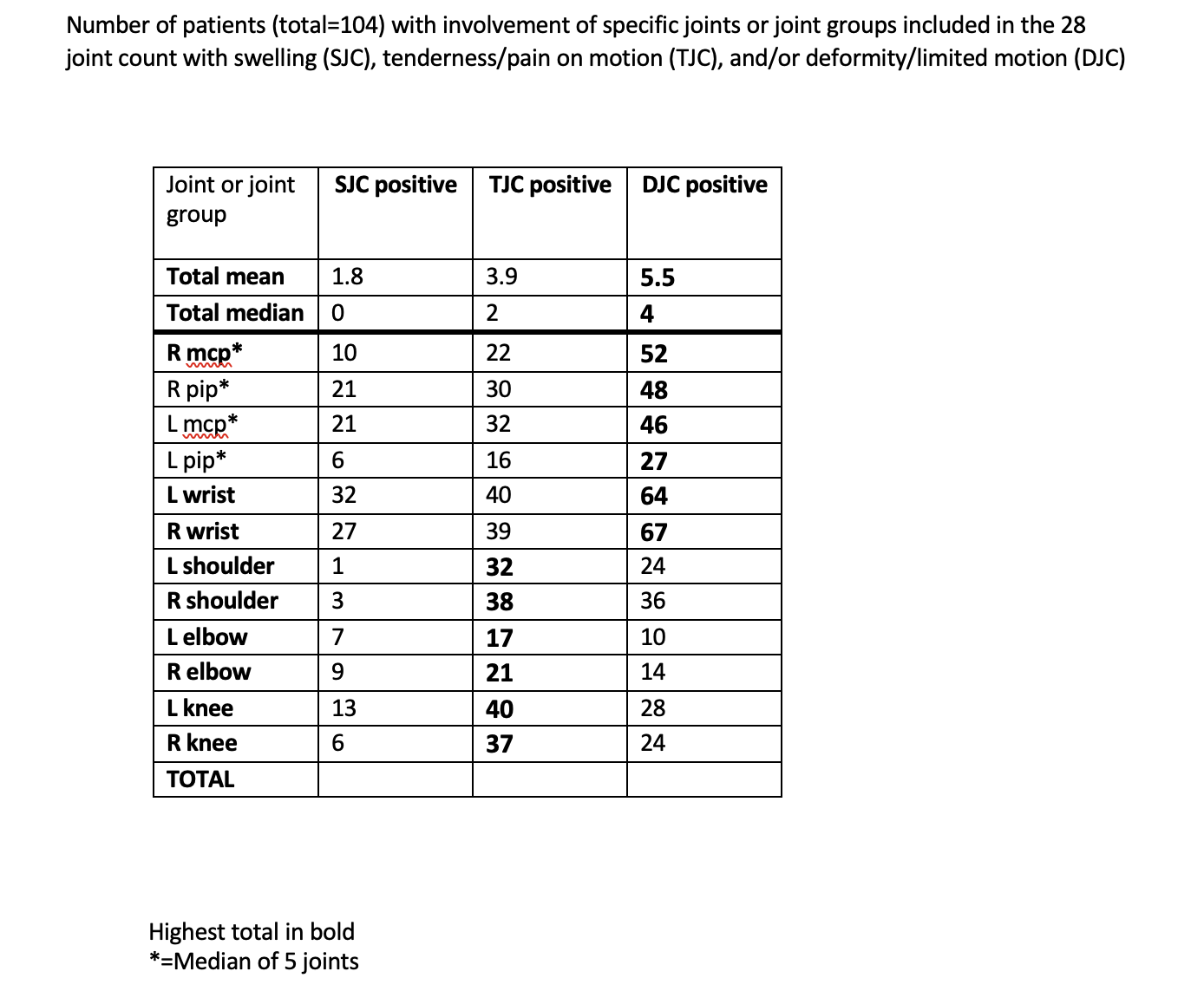Session Information
Session Type: Poster Session C
Session Time: 9:00AM-11:00AM
Background/Purpose: The 28 joint count for rheumatoid arthritis (RA) was designed to recognize 3 abnormalities: swelling, (SWL), tenderness/pain on motion (TEN), and deformity/limited motion (DEF), recorded as total swollen joint count (SJC), tender/pain on motion joint count (TJC), and deformed/limited motion joint count (DJC). In clinical trials over 6-12 months, DJC generally is omitted, appropriately, as the aim is to assess reduction of inflammation by active vs control treatments in groups of selected patients. However, omission of DJC has been extended to most long-term routine care and longitudinal databases, potentially underestimating the severity of patient status. We compared the likelihood of SWL, TEN and DEF in individual joints in 28 joint counts which were assessed in RA patients who had been treated over long periods.
Methods: A standard 28 joint count was performed at a routine care visit of 104 RA patients who had been treated over long periods, in which SWL, TEN and DEF were recorded for each joint. The total SJC, TJC, and DJC was recorded as totals of SWL, TEN and DEF in each of the 28 joints. The numbers of SWL, TEN and DEF of wrists, elbows, shoulders and knees were calculated for individual joints. Median values for 5 each of left (L) and right (R) interphalangeal (PIP) joints and metacarpophalangeal joints (MCP) were calculated to represent these joints.
Results: The study included 104 patients with mean and median age of 59.9 and 61.3 years and mean and median disease duration of 11.6 and 10.0 years, respectively. The mean and median total SJC was 1.8 and 0, TJC 3.9 and 2, and DJC 5.5 and 4, respectively (Table). The highest levels for all joint abnormalities were seen in wrists and lowest in elbows, although differences were not large. DEF was higher than SWL for all joints and joint groups included in the 28 joint count (Table). DEF was also higher than TEN for all 20 PIP and MCP joints (only 4 medians are included in the table) and wrists; TEN was marginally higher than DEF for shoulder, elbow, and knee joints.
Conclusion: Patients treated in the biological era with median disease duration of 10 years have low total SJC, reflecting excellent control of inflammation. However, joint deformity (and tenderness) are considerably more prevalent than swelling. Omission of deformity/limited motion, as is appropriately usual in clinical trials, in long-term care and longitudinal databases may give inappropriately favorable impressions of long-term RA outcomes. It is suggested that DJC be included in all formal joint counts in routine clinical care and long-term databases.
Highest total in bold
*=Median of 5 joints
To cite this abstract in AMA style:
Hunter R, Rodwell N, Pincus T. Each Joint in a 28 Joint Count Is More Likely to Be Affected by Deformity/Limited Motion Than by Swelling in Rheumatoid Arthritis Patients with Long Disease Duration: Deformity/Limited Motion Should Be Included in Joint Counts Performed in Routine Care [abstract]. Arthritis Rheumatol. 2023; 75 (suppl 9). https://acrabstracts.org/abstract/each-joint-in-a-28-joint-count-is-more-likely-to-be-affected-by-deformity-limited-motion-than-by-swelling-in-rheumatoid-arthritis-patients-with-long-disease-duration-deformity-limited-motion-should-b/. Accessed .« Back to ACR Convergence 2023
ACR Meeting Abstracts - https://acrabstracts.org/abstract/each-joint-in-a-28-joint-count-is-more-likely-to-be-affected-by-deformity-limited-motion-than-by-swelling-in-rheumatoid-arthritis-patients-with-long-disease-duration-deformity-limited-motion-should-b/

